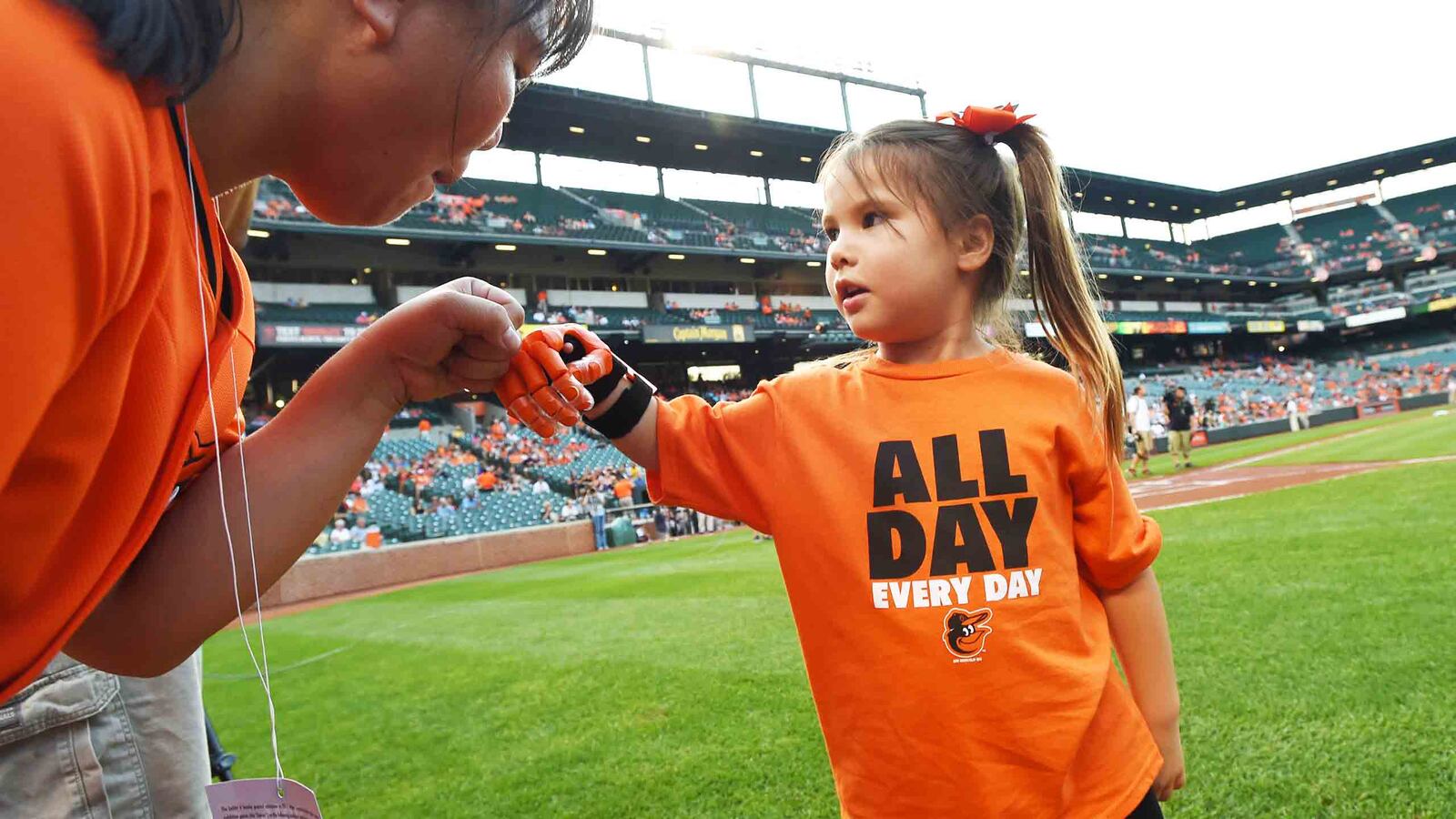On Saturday, the Los Angeles Dodgers and the Houston Astros will meet for Game 4 of the World Series. As with any Major League Baseball game, the competition will kick off with a ceremonial pitch. But this one will be especially awe-worthy, featuring a 7-year-old girl with a 3D-printed hand.
Hailey Dawson will fling the first baseball using a prosthetic hand that allows her to grip objects despite missing and underdeveloped fingers on her right side. When the invitation came in last month, “I started crying,” recalls Hailey’s mother Yong Dawson in an interview with CBS News. Hailey was born without a pectoral muscle on the right side, in a rare condition known as Poland syndrome. The resulting lack of blood flow to her arm meant that her right hand didn’t fully develop—she’s missing three fingers and has an underdeveloped thumb and pinky on her right hand. While she can do lots of things with her left hand, some things really take two.
And in Hailey’s baseball-crazy family, not being able to hold a bat with both hands was a huge blow.
At age 4, Hailey’s doctors told her parents that prosthetics just aren’t feasible for a child who will quickly outgrow them. Despite this, Hailey can now ride a bicycle and play in her hometown tee-ball league. Her 3D-printed hand has changed not only Hailey’s quality of life but how scientists are thinking about flexible, accessible, comfortable robotic hands.
“There are some really great robotic hands out there, but they’re very expensive,” Brendan O’Toole, chair of the mechanical engineering department at University of Nevada, Las Vegas, tells The Daily Beast. Hailey’s mother reached out to O’Toole after hearing about Robohand, a simple 3D-printed prosthetic with open-source design files. Theoretically, you can simply download, hit print, and have your own Robohand in a matter of hours. What Yong needed to find, she figured, was someone with access to a 3D printer.
A traditional prosthesis runs about $20,000, and Hailey would outgrow it in half a year. Hailey’s first hand was initially funded through grant for a summer research project by a couple of UNLV students. They adapted various open-source designs, particularly one called Flexy Hand 2, for her device.
It took more than half a year of design and prototypes to get the first hand right, says O’Toole. Subsequent ones are easier. The team has so far made about eight hands for Hailey, and two for another young girl. The university estimates that, after significant investments in refining the process, each new hand costs $5,000 in time, lab space, equipment, and materials. It is currently fundraising to make more prosthetic devices for more children.
“Additive manufacturing [3D printing] has made it possible to provide low-cost prosthetic devices for children like Hailey,” says O’Toole. “We can now make a few measurements of a child’s hand, process them through our custom design tool that generates 37 CAD [computer-aided design and drafting] models in a few minutes, and then have printed parts ready the next day.” The simplicity of the printing process belies the complexity of the work that goes into getting it right. The 3D printer reads the design files and prints the components by depositing material in layers to build up the shape. It takes only a matter of hours to complete the process. “Its beauty is in its simplicity,” O’Toole says. The prosthetic has a gauntlet that fits around Hailey’s wrist, which is attached to the robotic hand that fits over her own. The jointed fingers have a cable running through them, which attach to the gauntlet. By flexing at the wrist, Hailey puts tension on the cables, causing the device’s fingers to bend and grip. She relaxes, and the fingers open. It is designed to do only that one thing—grip and release. But that’s enough for a little girl who wants to hold onto both handlebars of her bike.
While in theory you can simply download and print these 3D designs, in practice every body is different and every device must meet different needs. A challenge for Hailey’s prosthesis was making it small enough to fit over her existing hand while maintaining strength and functionality, says O’Toole. The bigger challenge was to think about design in new ways that would simplify the steps and make it easier to adapt the concepts to other people’s needs in the future.
“That process is going to make prosthetic hands much cheaper and much more readily available,” O’Toole says. And this goes way beyond Hailey’s baseball dreams and those of other children with similar challenges.
The accessibility of 3D printing technology expands both possibilities and imaginations for engineers. “It really inspires students to want to create new devices and new things,” says O’Toole. Students at UNLV have contributed to patented designs for medical devices, including a flexible implant that could revolutionize knee replacement surgeries. They’ve printed devices that change the orientation of drone propellers, making them easier to control. They’ve printed all sorts of fun stuff, like dinosaur models and complex mechanisms. The list goes on and on. “Students can generate prototypes, test them, and improve their original designs at a pace that was not possible five-to-10 years ago.”
As for Hailey, she has her sights set on pitching at every single Major League Baseball stadium. After a tweet stating that goal last month, the invitations came pouring in. Saturday’s game will be her World Series debut, but it won’t be the last you hear from her.





